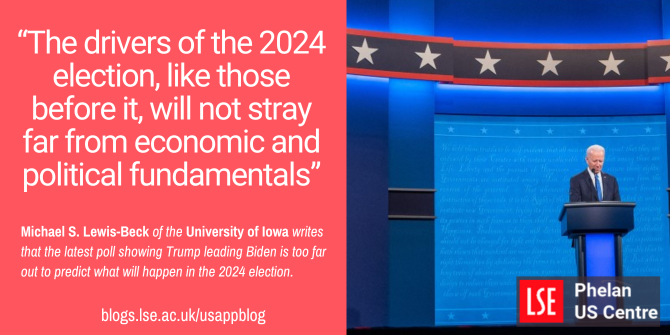 Public opinion polls on vote intention in US presidential elections often generate considerable interest, as possible predictors of who will win the political “horse race.” Michael S. Lewis-Beck considers a recent NYT-Siena poll which suggests that former President Donald Trump is currently leading President Joe Biden in the 2024 election race. Looking at the accuracy of past polls this far away from presidential elections, he argues that this latest poll is unlikely to be a good prediction of what will happen in November 2024.
Public opinion polls on vote intention in US presidential elections often generate considerable interest, as possible predictors of who will win the political “horse race.” Michael S. Lewis-Beck considers a recent NYT-Siena poll which suggests that former President Donald Trump is currently leading President Joe Biden in the 2024 election race. Looking at the accuracy of past polls this far away from presidential elections, he argues that this latest poll is unlikely to be a good prediction of what will happen in November 2024.
A recent, highly visible, presidential NYT-Siena Poll found “Trump leads in 5 Critical States.” Does this mean that former President Donald Trump will win the US presidential election next November? Or, as a forecast of the 2024 contest, is it mostly meaningless since the event predicted will not take place for another year? I would answer, ‘Yes,’ it has little value, since it lacks predictive power. Simply put, it’s “too far out,” as argued in a recent article modeling the accuracy-lead trade off. In general, with respect to democratic systems, the closer the poll to the election, the more accurate the forecast. Regarding US presidential elections, national public opinion vote intentions data (1952 and after), gathered 300 days or more from the contest, tell us next to nothing about who will win. If we were to look at a regression scatter plot relating poll share to vote share, it would look random, pretty much like a chocolate chip cookie.
The limitations of political polling
A skeptic may argue that the polls at hand are somehow different from other vote intention polls, in their ability to foretell the future. That would be highly unlikely, given the track record of vote intention polls in forecasting the 2020 US presidential elections. To illustrate, in 2022, Natalie Jackson, then of the Public Religion Research Institute, and I analyzed 322 national presidential vote intention polls from 2020, and found that the mean prediction error (i.e., the difference between the poll estimate and the actual popular vote result) was high, at 4.9 percentage points (even higher than in the 2016 race). Such findings suggest that the poll under discussion may not be free of such bias. The underlying source of the difficulty comes from an existential problem—pollsters are trying to sample a population that does not yet exist, namely the voters themselves. They hope that those who are interviewed will, in relevant ways, represent the population that will go to the voting booths in November.

“Final Presidential Debate at Belmont Uni” (CC BY-NC-SA 2.0) by Biden For President
Political pollsters, such as the serious students of politics we have here, do, indeed, pay attention to methodological issues, including problems of sampling and design (see their detailed appendix). They focus on battleground states, which has utility, but battleground states sometimes change, and do not generally represent the whole country. In this instance, they include Nevada, Georgia, Arizona, Michigan, Pennsylvania, Wisconsin. (One might ask, for example, where is Iowa? New Hampshire?) They indicate that the total sample size for these six states, was 3,662 registered voters. That number sounds impressive but dividing it by 6 yields a N ~ 610, not a very large sample for each state. Further, they indicate the margin of error for each state is between 4.4 and 4.8 percentage points. Putting this wide confidence band around each state estimate for, say Biden, implies his percentage vote share, instead of falling in the “losing” category could, within acceptable boundaries of error, have fallen in the “winning” category (except perhaps for Nevada, where the gap is 10 percentage points).
How important are the economic and political fundamentals in the 2024 race?
Biden does appear, on the face of these polling data, to be in a tough race. Will this impression sustain itself down the road? According to analysis of the other data just discussed, the responses recorded in these October-November 2023 surveys probably have little practical bearing on who will win a year from now. Will the sometimes-surprising views on the issues they offer sustain themselves? Take the glaring example of the economy. According to these latest New York Times surveys, “Economic indicators are up even if voters do not agree with them.” This suggests that traditional economic voting, where the incumbent receives a reward for good economic performance, no longer operates. That would mean the rupture of a classic economic axiom in voting behavior. While the death of economic voting has been heralded, it has managed to sustain itself as a pivotal force, in the several national elections where Trump, as candidate or president, has been featured.
One implication is that the drivers of the 2024 election, like those before it, will not stray far from economic and political fundamentals. As the dynamics of the election unfold over time and voters focus more seriously on their interests and issues, the contours of the outcome will become clearer. The national polls themselves, in reporting vote intentions, will gain in forecasting accuracy as they close in on the November contest. Will these later surveys sustain this current finding, that Biden and Trump are running neck-and-neck? In general, a three-month lead time optimizes the forecasting accuracy of such surveys, implying the polling results from mid-summer bear careful consideration.
- Please read our comments policy before commenting.
- Note: This article gives the views of the author, and not the position of USAPP – American Politics and Policy, nor the London School of Economics.
- Shortened URL for this post: https://bit.ly/3u6hfaJ






